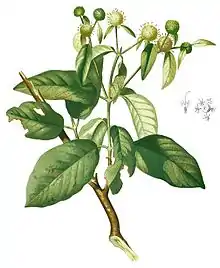| Mitragyna diversifolia | |
|---|---|
 | |
| Illustrated as "Stephegyne diversifolia" | |
| Scientific classification | |
| Kingdom: | Plantae |
| Clade: | Tracheophytes |
| Clade: | Angiosperms |
| Clade: | Eudicots |
| Clade: | Asterids |
| Order: | Gentianales |
| Family: | Rubiaceae |
| Genus: | Mitragyna |
| Species: | M. diversifolia |
| Binomial name | |
| Mitragyna diversifolia | |
| Synonyms | |
|
Stephegyne tubulosa Fern.-Vill. | |
Mitragyna diversifolia[2] is a tree species in the family Rubiaceae and found in Asia.[3][4] The Catalogue of Life lists no subspecies.[3]
Description
Mitragyna diversifolia is a deciduous under-story tree, that reaches up to 15 m in height. The branches are angled and cylindrical. The leaves are ovate-oblong to elliptic-ovate, averaging 146 × 93 mm in size, obtuse apex to shortly acuminate. The yellow corolla has white lobes. The fruit in the form of a capsule of 3–4 mm.[5]
Distribution
It is distributed through the forests of China (Yunnan), Cambodia, Indonesia, Laos, Burma, the Philippines, Thailand and Vietnam.
Uses
The genus mitragyna has been used traditionally to alleviate symptoms of fever, coughing, diarrhea, muscular pain and deworming,[6] although antioxidant and antimicrobial properties have also been found.[7] Typically these are consumed as a whole leaf or powder form, although gel-capsules, containing powder, are also used. Mitragyna diversifolia has been shown to possess pharmacological antidiarrheal properties, as well as analgesic properties.[8]
Phytochemicals
Mitragyna diversifolia leaf contains the alkaloids 7-hydroxy-isopaynantheine, 3-dehydro-paynantheine, 3-isopaynantheine-N(4)- oxide, mitrafoline, mitradiversifoline, specionoxeine-N(4)-oxide, specionoxeine-N(4)-oxide.[9]
Gallery
References
- ↑ The Plant List: Mitragyna diversifolia (accessed 3/6/2013
- ↑ Haviland GD (1897) Journal of the Linnean Society, Botany 33: 71.
- 1 2 Roskov Y.; Kunze T.; Orrell T.; Abucay L.; Paglinawan L.; Culham A.; Bailly N.; Kirk P.; Bourgoin T.; Baillargeon G.; Decock W.; De Wever A. (2014). Didžiulis V. (ed.). "Species 2000 & ITIS Catalogue of Life: 2014 Annual Checklist". Species 2000: Reading, UK. Retrieved 26 May 2014.
- ↑ WCSP: World Checklist of Selected Plant Families
- ↑ Mitragyna diversifolia in Flora of China
- ↑ Gong, Fang; Gu, Hai-Peng; Xu, Qi-tai; Kang, Wen-yi (2012). "Genus Mitragyna: Ethnomedicinal uses and pharmacological studies" (PDF). Phytopharmacology. 3 (2): 263–272. Retrieved 17 June 2020.
- ↑ Parthasarathy, Suhanya; Bin Azizi, Juzaili; Ramanathan, Surash; Ismail, Sabariah; Sasidharan, Sreenivasan; Said, Moh Ikram Mohd.; Mansor, Sharif Mahsufi (2009). "Evaluation of Antioxidant and Antibacterial Activities of Aqueous, Methanolic and Alkaloid Extracts from Mitragyna Speciosa (Rubiaceae Family) Leaves". Molecules. 14 (10): 3964–3974. doi:10.3390/molecules14103964. PMC 6255380. PMID 19924042.
- ↑ Jebunnessa; Uddin, Shaikh Bokhtear; Mahabub-Uz-Zaman, Mohammed; Akter, Rasheda; Ahmed, Nazim Uddin (2009). "Antidiarrheal activity of ethanolic bark extract of Mitragyna diversifolia". Bangladesh Journal of Pharmacology. 4 (2): 144–146. doi:10.3329/bjp.v4i2.2801.
- ↑ Ahmad, I.; Prabowo, W. C.; Arifuddin, M.; Fadraersada, J.; Indriyanti, N.; Herman, H.; Purwoko, R. Y.; Nainu, F.; Rahmadi, A.; Paramita, S.; Kuncoro, H.; Mita, N.; Narsa, A. C.; Prasetya, F.; Ibrahim, A.; Rijai, L.; Alam, G.; Mun'Im, A.; Dej-Adisai, S. (2022). "Mitragyna Species as Pharmacological Agents: From Abuse to Promising Pharmaceutical Products". Life. 12 (2): 193. Bibcode:2022Life...12..193A. doi:10.3390/life12020193. PMC 8878704. PMID 35207481.
External links
 Media related to Mitragyna diversifolia at Wikimedia Commons
Media related to Mitragyna diversifolia at Wikimedia Commons Data related to Mitragyna diversifolia at Wikispecies
Data related to Mitragyna diversifolia at Wikispecies- IPNI: Mitragyna diversifolia (accessed 2/7/2017)
